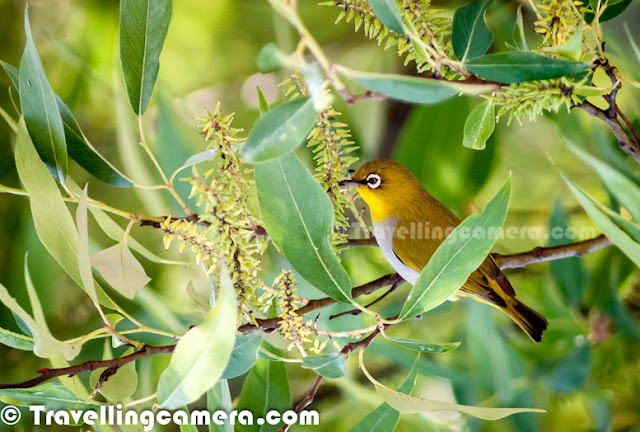During Diwali Vacations at my Home in Himachal Pradesh, I met various birds in our backyard. This time, there was a huge flock of small yellow birds on one of the trees around our home. These birds used to come every morning at around 9am when this tree gets first rays of sunlight. Let's check out this Photo Journey to know more about these birds and what all they do there.

Out of all birds shared HERE, these yellow birds are most active and that motivated me to just focus on these birds this time. All these photographs are clicked during three mornings I spent at Home in Mandi, Himachal Pradesh.
Not sure, if she noticed me in my balcony carrying a huge camera or trying to show something else :) ...
These birds hardly spend 30 seconds on one branch. They keep flying from one branch of the tree to another. Tree was very dense and initially I was spending 90% of time locating them. They were in big number but still it was hard to locate these small birds on a dense branched tree. Above photograph is one of my favorite shot when one of the bird is exactly looking at me.
The name of this bird is - Oriental White-eye, which is a small passerine bird in the white-eye family. It is a resident breeder in open woodland in tropical Asia, east from the Indian Subcontinent to Southeast Asia, extending to Indonesia and Malaysia. These birds forage in small groups, feeding on nectar and small insects. They are easily identified by the distinctive white eye-ring and overall yellowish upper parts. Several populations of this widespread species are named subspecies and some have distinctive variations in the extent and shades of yellows in their plumage.
These birds are quite mischievous.
These white-eyes are sociable, forming flocks which only separate on the approach of the breeding season. They are highly arboreal and only rarely descend to the ground. The breeding season is February to September but April is the peak breeding season and the compact cup nest is a placed like a hammock on the fork of a branch. The nest is made of cobwebs, lichens and plant fiber. The nest is built in about 4 days and the two pale blue eggs are laid within a couple of days of each other. The eggs hatch in about 10 days. Both sexes take care of brooding the chicks which fledge in about 10 days. Though mainly insectivorous, the Oriental White-eye will also eat nectar and fruits of various kinds

A flying Oriental White-eye bird.
This bird is small (about 8 cm long) with yellowish olive upper parts, a white eye ring, yellow throat and vent. The belly is whitish grey but may have yellow in some subspecies. Both Male and female Oriental White-eye look similar.


.jpg)
.jpg)
.jpg)


.jpg)
Comments
Thanks for dropping the message. Exif for which Pic? as it would be different for all of them. I would recommend to download and see in any of the Digital Imaging software. If you specify a particular pic, I would love to share.
Also wondering that why u need to know about Exif? (for my knowledge :) )
Cheers,
VJ